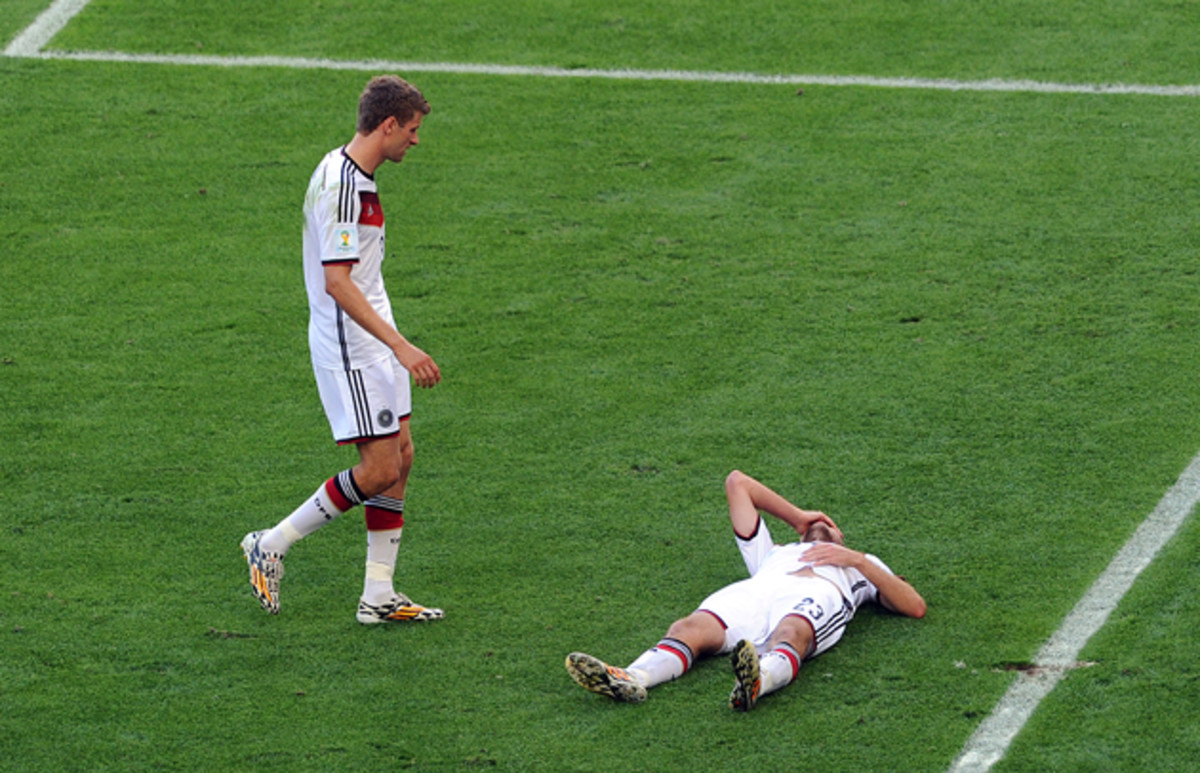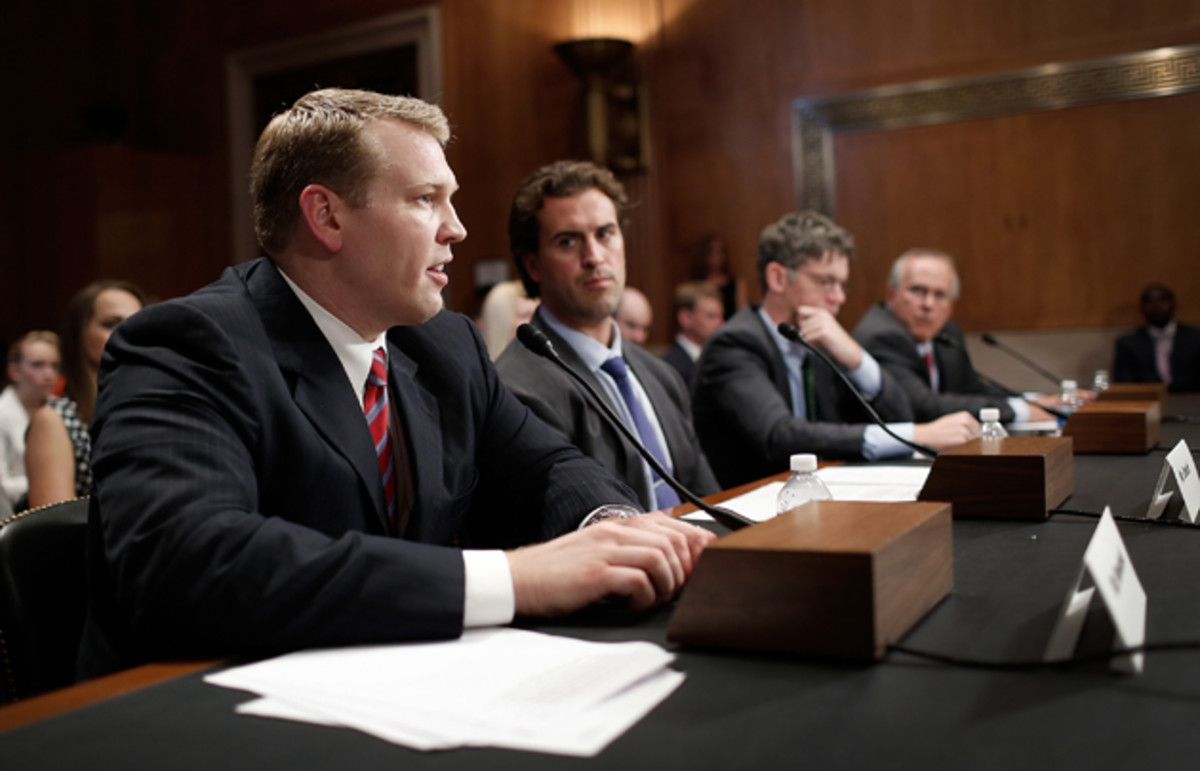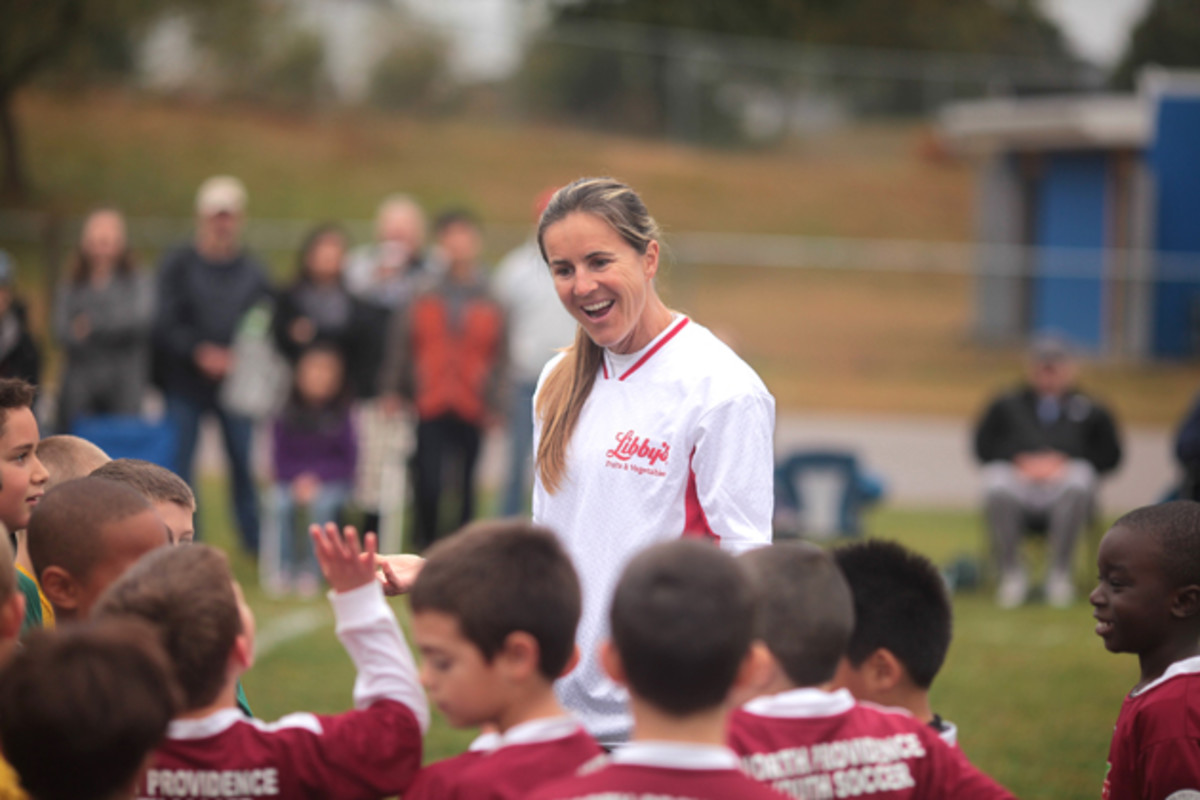With concussion reform at forefront, should youth headers be nixed?

One of the first goals Andrew Liotta remembers scoring came off a header. Liotta, who was in elementary school at the time, was playing on the right side of the midfield. With the ball on the left flank, he made a run for the back post unmarked. He received a cross and headed the ball into the net.
“It was a really cool feeling, because it seemed special to score a header,” Liotta recalls. “Most goals in youth soccer aren’t scored off headers, especially at that age, so it was great.”
Liotta, now a 19-year-old junior at Massachusetts Institute of Technology, grew up on the soccer fields of Northern California. The arc of his soccer career was similar to a number of youth players. He played for his club and school, falling in love with the game at an early age and playing throughout his childhood. He was ultimately good enough to join MIT’s team as a defender.
But Liotta’s story is also common in another, more unsettling way: Concussions ended his playing career prematurely. The same head that scored one of his first goals also brought an end to his days of playing soccer competitively.
FIFA slow to embrace reform
Soccer’s concussion problem, long an afterthought behind the head trauma issues of other sports perceived as more violent – particularly football – is commanding more attention. During this summer’s World Cup, many observers criticized FIFA for its handling of head injuries. In one instance, Germany’s Christoph Kramer collided with another player during the first half of the World Cup final, yet continued playing for nearly 15 minutes after suffering the injury. He later said he couldn’t remember anything from the opening half of the match.

Uruguay's Alvaro Pereira was clearly knocked out during a game in the group stage, yet refused a trainer's substitution order and played on. Countless other players around the world have been victims of head injuries, including prominent cases like those of former MLS star and staunch concussion advocate Taylor Twellman and Tottenham goalkeeper Hugo Lloris.
Even though FIFA’s medical chief on Tuesday called for some reform to concussion protocol, the organization has continually downplayed soccer’s head trauma issue. “We are not alarmed,” Jiri Dvorak, the chief medical officer for FIFA’s medical and research center, told USA Today in late August.
Proponents of reform strongly disagree.
“FIFA is where the NFL was in 2006,” says Chris Nowinski, a former pro wrestler, college football player and current president of the Sports Legacy Institute and author of Head Games. “They say everything is under control and that we shouldn’t worry about it. It really isn’t under control. FIFA refuses to acknowledge there is a crisis.”
The Centers for Disease Control estimates there were 10,436 emergency room visits each year from 2001-2009 from soccer-related traumatic brain injuries among those ages 19 and younger. But approximations of head injury occurrences are generally far lower than in reality because concussions often go unreported. Just like the case of Kramer, soccer players on all levels often play through a concussion or fail to report the injury.
High school athletes still suffer far more serious head injuries playing football and ice hockey than soccer, according to a study by RIO, which tracks concussion rates in high school sports. But Nowinski and other close observers say football has done more to improve player safety, from the NFL down to youth leagues, than soccer.
Liotta may seem completely unrelated to Kramer or any other professional who has suffered head injuries. But FIFA’s Laws of the Game are used by almost every soccer organization in America, and while FIFA has guidelines for identifying concussions, there are no actual rules for managing head injuries.
In absence of any real initiative by FIFA to increase player safety, the push for serious concussion reform in the United States is coming from an array of groups of parents, players, medical experts and safety advocates. In August, a group of parents and former youth players filed a lawsuit against FIFA alleging the organization was negligent in its supervision of head injuries.
Advocates of reform have pushed for a number of changes on the youth level, including increasing the presence of athletic trainers at matches, educating coaches and parents on best head safety practices, and developing a greater scientific understanding of head trauma in soccer through longitudinal studies.
But recently, proponents of change have turned their attention to a specific aspect of soccer: whether to allow youth players to head the ball.

A push to reduce youth head injuries
In June, Nowinski’s Sports Legacy Institute announced a partnership with Santa Clara University’s Institute of Sports Law and Ethics to create a new initiative, called Parents and Pros for Safer Soccer, which is aiming to minimize or eliminate heading before high school. Dr. Robert Cantu, one of the world’s leading experts on head trauma in sport and a clinical professor of neurosurgery at Boston University School of Medicine, has pointed to studies showing at least 30 percent of concussions in soccer come from the act of heading the ball, sometimes through direct contact with the ball but more significantly when the head smashes into another player or the ground. Cantu is also involved in the new initiative.
The brains and bodies of children are still developing, meaning they are more susceptible to concussions. Recurring head injuries also become more likely each time an individual suffers a concussion. Based on those reasons, as well as the fact that roughly eight million youths play soccer in America, the group decided a potentially effective way to take on soccer’s head trauma problem was to minimize heading before age 14, or more specifically prior to high school.
One of the leading crusaders for heading reform at the youth level is former United States international Brandi Chastain, who clinched the 1999 Women's World Cup with her penalty kick and also won an Olympic gold medal during her career. Chastain, who is the most prominent professional soccer player directly tied to Parents and Pros for Safer Soccer, admits she took pride in her own ability to head the ball.
“I always headed the ball. I was the best at it. I loved heading the ball, and I was the one who had the courage to do it when a punt came,” she says. “I’m sure in the long run, when someone is looking at my brain one day, they’re going to see some interesting things.”
A common criticism of the push to minimize headers for youth players is that kids won’t understand how to properly head the ball. Critics also charge that kids, after watching their favorite professionals head the ball, will simply head the ball anyway. Chastain rejects these criticisms and argues that it would be more beneficial for American soccer players to learn footwork and agility, rather than heading, at a young age. Plus, kids can learn proper heading technique using a softer ball, like a beach ball.
“When a kid is younger, they don’t understand space awareness, timing, tactics or body position. They’re not physically strong enough,” Chastain says. “We should teach them other things now, so that when they’re 14 and they can understand more about heading, they’ll be more ready to head the ball than 8 year olds.”

When concussions end a career
Liotta, like many kids, starting heading the ball from an early age. Some U.S. youth soccer organizations, like American Youth Soccer Organization (AYSO), suggest that coaches avoid teaching heading before age 10, but this guideline often goes unenforced. (AYSO’s guidelines recommend that players start heading with a softer ball.) U.S. Youth Soccer even has a lesson plan for heading on its website specifically geared toward players under 10.
Liotta suffered four concussions before he gave up soccer. He suffered his first diagnosed concussion at 14, when his landed on the field after going up for a header. His second concussion came in a high school playoff match during his senior year when a cross near the corner flag drilled him in the head. The force was so great that he staggered back and fell down, the back of his head smashing against a running track that surrounded the field. Liotta has no recollection of 15 minutes from that match.
His third concussion came as a freshman defender for MIT in a match against Tufts. He launched himself for a header and cracked heads with an opposing player. Liotta stayed in the match, helping MIT to a comeback 2-1 victory, but afterwards he felt depressed – a concussion after-effect.
After his third concussion, Liotta and his parents debated whether he should continue playing soccer. They ultimately decided that he could continue playing, with two caveats: He’d have to wear a protective headgear, and he would have to quit if he suffered one more concussion. During the first official preseason practice of his sophomore year, Liotta suffered another concussion during a 2-on-2 drill. He was hit in the jaw by a touch pass that was flicked upward, catching him on the way up. Liotta’s soccer career was over. He couldn’t risk another injury and the possibility of permanent brain damage.
MORE: Former Clemson women's player files lawsuit over alleged hazing-induced head trauma
Subconcussive impact and soccer
It’s impossible to know whether the thousands of headers Liotta took throughout his youth career contributed to his concussions. Heading the ball is considered a subconcussive blow – a head impact that does not immediately display symptoms of head trauma – which Cantu and numerous other experts say leads to concussions and brain damage down the road, including chronic traumatic encephalopathy (CTE).
A study published in Radiology in 2013, conducted by researchers from Yeshiva University, concluded that “repetitive subconcussive head trauma in the setting of heading during soccer may be associated with white matter microstructural and neurocognitive changes similar to those seen in patients with traumatic brain injury.” In other words, heading the ball can cause long-term brain damage. The death of former soccer player Patrick Grange at age 29 and the subsequent discovery of CTE in his brain lend anecdotal evidence to this conclusion.
At this point, longitudinal studies at the youth level are largely non-existent, Cantu admits. These studies are expensive (Cantu estimates they would cost tens of millions of dollars) and require many years of documentation. But Cantu – who is as an adviser to the NFL’s Head, Neck and Spine Committee as well as a number of individual teams – firmly believes that heading the ball repeatedly is extremely dangerous.
“Those [longitudinal] studies should be done, but there have been enough smaller studies and we know enough from boxing, football and ice hockey and smaller studies,” he says. “When you rattle the brain inside the head, it doesn’t know whether it’s a physical assault, a fall, athletics, a seizure or you’re banging your head. But bad things happen when you do that if you do it enough.”
A successful reformer meets resistance
Even with medical research seemingly on the side of minimizing headers for young soccer players, proponents of reform expect change to be slow. One barrier to reform, besides FIFA’s general acceptance of the status quo, is that youth soccer organizations in the United States aren’t governed by the exact same rules. If one league decides to ban heading and a parent wants his or her kid to head the ball, the kid can simply join another league. Different states and regions often have discrepancies within their rules as well.
One of the more successful reformers on the state level has been Doug Andreassen, who spent seven years as the president of Washington Youth Soccer and is now the committee chair for U.S. Soccer’s Diversity Task Force. He helped pass the Zackery Lystead Law in Washington in 2009. Named for a boy who was permanently disabled after he suffered a concussion playing football and returned to the game, the legislation mandates that youth athletes displaying symptoms of a concussion must be cleared by a licensed professional before returning to action.
Andreassen has continued to push for reform over the last few years, helping Washington Youth Soccer implement a number of new concussion safety protocols as well as a new risk management program. Since he began campaigning for greater safety regulations in soccer eight years ago, he has dealt with a lot of pushback from both coaches and parents.
People told him that he didn’t understand the game and that heading was an integral aspect of soccer, even for kids. He still regularly hears from critics who say that he’s trying to change the game or that he’s discouraging kids from playing sports. Andreassen rejects these charges, saying he fully supports youth participation in sports.
“The main criticism I receive is that I’m fear mongering, and that this is in fact not causing damage,” he said. “Parents will say that if their kid tells them they have a headache then they’ll have the kid stop playing. Well, it’s too late in that case.”
Andreassen believes the education of parents, youth soccer administrators and coaches is an essential step toward substantially reducing concussions among youths. He perceives an old-school mindset among administrators that he feels is the most significant factor holding back change. He also believes gender has played a role in the reluctance among many to embrace change.
“Women need to become involved in this. We need moms involved in making youth decisions,” Andreassen says. “The hierarchy we have of males that dominate youth soccer in coaching and administrators is shocking to me. The attitude is that 'we don’t have a concussion problem.'”
In Washington, 11 of 13 members of Washington Youth Soccer’s Board of Directors are male. Nationally, AYSO’s Board of Directors has one female and 10 males, while U.S. Youth Soccer’s Board of Directors has two females and nine males. Washington has been progressive in its reforms, but Andreassen believes the underrepresentation of women in leadership roles has held back change around the country.
Katherine Snedaker, a safety advocate who founded awareness website SportsCapp.com and female concussion resource PinkConcussions.com, has also been trying to create change at the ground level. But she, like Andreassen, has had trouble getting her message across.
“I can’t get my local soccer organization to let me talk about concussions,” she says. “I’ve had more access to Roger Goodell than the president of my local youth soccer league.”
Like other reformers, Snedaker stresses that minimizing heading at the youth level isn’t the only answer to the concussion problem. She has pushed to increase the presence of athletic trainers at youth sporting events, as if they were lifeguards on a beach.
But she does believe heading needs to be limited. She said that she’d be interested in a hypothetical experiment in which one state bans heading under age certain age while another keeps heading in place, in order to see the difference in head injuries. Thanks to an ambitious private school in Pennsylvania, she may get to see something similar.
A school takes on concussions
The Shipley School is a private school in Bryn Mawr, Pennsylvania, just outside Philadelphia. Steve Piltch, the head of the school since 1992, has recently earned national media attention for Shipley’s new “no heading” policy for middle school soccer players. After a long debate among school administrators and athletic personnel, the school announced a new policy this May, under which players are instructed to not head the ball.
Though the school acknowledges the possibility of incidental heading during games, the goal is to reduce concussions in students by eliminating heading before high school. Students who repeatedly and intentionally head the ball during matches will be pulled aside and spoken to. Kids will be taught heading technique using a lighter ball, and other schools will be invited to participate as well. Shipley also plans to use sensors to monitor blows to the head among athletes, which will give the school data over a period of several years.
Carlos Bocanegra's leadership made retiring USA star a valuable linchpin
Piltch has a personal connection to the concussion crisis, as his own children have suffered serious head injuries while playing sports. He also points out that head injuries can have a serious detrimental effect on a student’s academics. The new policy was put in place to protect the health and general wellbeing of the school’s students, but he also hopes to create broader change.
“We believed that unless we were willing to take the initiative and others did the same, you weren’t going to see large-scale organizations changing,” Piltch says. “There are those who think we made the wrong decision. I don’t believe any decision made in the interest of kids’ health is ever the wrong decision.”
Mark Duncan, Shipley’s athletic director, says that the school community has been unified in its support for the new policy. He says he received a flurry of what he says were hate emails and voicemails when the policy first received national media attention, but that those subsided fairly quickly.
“In games, we’re asking kids not to head the ball. But we’re not trying to change the sport,” Duncan says. “Our high school kids will still head the ball, but they’re going to learn to do so safely.”
Bigger changes on the way?
In perhaps the most significant challenge to the status quo in soccer, three mothers whose children played youth soccer and two college students who played youth soccer filed a class-action lawsuit against FIFA in late August. The lawsuit also names the U.S. Soccer Federation, U.S. Youth Soccer and AYSO as defendants, among a couple other American organizations.
The lawsuit accuses FIFA of negligence in its management of concussions. The suit demands rule changes and the establishment of new policies, including a limit on the frequency of heading under the age of 17.
Sunil Gulati quells talk of USA-Canada future joint World Cup hosting bid
Steve W. Berman, the attorney for the plaintiffs, played goalkeeper at University of Michigan, where he completed his undergraduate studies. He recalls one game when he stopped the ball with his face rather than his hands after being too slow to react to a ball. He was dazed, seeing stars and flashing lights. For a moment, he was confused about where he was.
“Looking back, it’s classic,” he says. “I was concussed. But back then, people didn’t understand it and you just went on. I don’t fault the school, because the state of the art wasn’t what it is now.” Berman finished the match in net.
This isn’t the first time Berman has dealt with concussions in court. Berman is also representing a group of NCAA student-athletes in a suit, in which he is attempting to win approval of a $75 million concussion settlement from the NCAA. He says that when he started examining FIFA protocols, he quickly arrived at the conclusion that their practices were inadequate.
“Anyone who is involved in the game knows that the game is covered by FIFA’s Laws of the Game. Every organization follows FIFA’s Laws of the Game,” Berman says. “They have the power to make changes and protect these players.”
Walking away from the game
Andrew Liotta no longer plays competitive soccer. Liotta, who is studying aeronautical and astronautical engineering at MIT, still lives with members of the soccer team. Occasionally, he’ll watch the team practice or even lightly kick around the ball in a non-competitive pickup match, still in love with the game but unable to fully participate.
“Quitting was absolutely miserable. To this day it still hurts,” he says. “There’s not a day that goes by that I don’t wish I was still on the field.”
After he received his fourth concussion, he called home. The phone call was one of the toughest things he has done in his life. He told his father that he was no longer going to be playing soccer. Liotta cried over the phone.
Liotta wonders what would happen if he had a fifth concussion. Would he be fine, or would he have long-term brain damage? “At the end of the day, I’m only 19 and I’m not going to give up the other things I love,” he says.
Even knowing how his career turned out, Liotta still says he would have played soccer the same way. He would have gone up for the header that gave him the concussion during his freshman year of college, and he believes heading is an essential part of the game.
The immediate aftereffects of concussions – the depression, darkness, sensitivity to light and sensitivity to noise Liotta experienced – are long gone. But his concussions are still on his mind. When he gets a bad headache, he can’t help but wonder whether his head is reminding him how it was treated on the soccer field.
“Do you need a 5-year-old heading the ball?” Liotta says. “Probably not.”
